The Impact of Technological Parameters on the Quality of Inkjet-Printed Structures
Abstract
:1. Introduction
2. Materials and Methods
3. Results
3.1. The Effect of the Drop Space
3.2. The Effect of the Cartridge Height
3.3. The Effect of Table Temperature
3.4. The Effect of Temperature and Sintering Time on Electrical Resistance
3.5. The Effect of Accelerated and Bending Tests on Electrical Parameters
4. Conclusions
Funding
Data Availability Statement
Conflicts of Interest
References
- Available online: https://www.scopus.com/ (accessed on 20 January 2023).
- Khan, S.; Lorenzelli, L.; Dahiya, R.S. Technologies for printing sensors and electronics over large flexible substrates: A review. IEEE Sens. J. 2015, 15, 3164–3185. [Google Scholar] [CrossRef]
- Zikulnig, J.; Chang, S.; Bito, J.; Rauter, L.; Roshanghias, A.; Carrara, S.; Kosel, J. Printed Electronics Technologies for Additive Manufacturing of Hybrid Electronic Sensor Systems. Adv. Sens. Res. 2023, 7, 2200073. [Google Scholar] [CrossRef]
- Suresh, R.R.; Lakshmanakumar, M.; Arockia Jayalatha, J.B.B.; Rajan, K.S.; Sethuraman, S.; Krishnan, U.M.; Rayappan, J.B.B. Fabrication of Screen-Printed Electrodes: Opportunities and Challenges. J. Mater. Sci. 2021, 56, 8951–9006. [Google Scholar] [CrossRef]
- Bidoki, S.M.; Nouri, J.; Heidari, A.A. Inkjet deposited circuit components. J. Micromech. Microeng. 2010, 20, 055023. [Google Scholar] [CrossRef]
- Amruth, C.; Luszczynska, B.; Rekab, W.; Szymanski, M.Z.; Ulanski, J. Inkjet printing of an electron injection layer: New role of cesium carbonate interlayer in polymer oleds. Polymers 2021, 13, 80. [Google Scholar] [CrossRef]
- Kuang, M.; Wang, J.; Bao, B.; Li, F.; Wang, L.; Jiang, L.; Song, Y. Inkjet Printing Patterned Photonic Crystal Domes for Wide Viewing-Angle Displays by Controlling the Sliding Three Phase Contact Line. Adv. Opt. Mater. 2014, 2, 34–38. [Google Scholar] [CrossRef]
- Karunakaran, S.K.; Arumugam, G.M.; Yang, W.; Ge, S.; Khan, S.N.; Lin, X.; Yang, G. Recent progress in inkjet-printed solar cells. J. Mater. Chem. A Mater. 2019, 7, 13873–13902. [Google Scholar] [CrossRef]
- Das, S.; Venkatakrishnan, A.; Yamamoto, H.; Watson, G.P. Fabrication of Organic Thin Film Transistors Using Inkjet Printing of PEDOT:PSS; Singh Center for Nanotechnology: Philadelphia, PA, USA, 2019. [Google Scholar]
- Liu, Y.; Cui, T.; Varahramyan, K. All-polymer capacitor fabricated with inkjet printing technique. Solid. State Electron. 2003, 47, 1543–1548. [Google Scholar] [CrossRef]
- Kiliszkiewicz, M.; Jasińska, L.; Dziedzic, A. The ink-jet printed flexible interdigital capacitors: Manufacturing and ageing tests. Flex. Print. Electron. 2023, 8, 035016. [Google Scholar] [CrossRef]
- Szostak, K.; Słobodzian, P.; Kiliszkiewicz, M.; Jasińska, L.; Slobodzian, P.; Korbutowicz, R.; Malecha, K. Inkjet Printed vs Screen Printed Microstrip Line on LTCC Substrates. In Proceedings of the 2019 Conference on Microwave Techniques (COMITE), Pardubice, Czech Republic, 16–18 April 2019. [Google Scholar] [CrossRef]
- Jasińska, L.; Szostak, K.; Kiliszkiewicz, M.; Słobodzian, P.; Malecha, K. Ink-jet printed ring resonator with integrated Microfluidic components. Circuit World 2020, 46, 301–306. [Google Scholar] [CrossRef]
- Gieva, E.; Nikolov, G.; Nikolova, B. Sheet Resistance Measurement of Inkjet Printed Layers. In Proceedings of the 2019 42nd International Spring Seminar on Electronics Technology (ISSE), Wroclaw, Poland, 15–19 May 2019. [Google Scholar] [CrossRef]
- Zikulnig, J.; Roshanghias, A.; Rauter, L.; Hirschl, C. Evaluation of the Sheet Resistance of Inkjet-Printed Ag-Layers on Flexible, Uncoated Paper Substrates Using Van-der-Pauw’s Method. Sensors 2020, 20, 2398. [Google Scholar] [CrossRef] [PubMed]
- Molina-Lopez, F.; Quintero, A.V.; Mattana, G.; Briand, D.; de Rooij, N.F. Large-area compatible fabrication and encapsulation of inkjet-printed humidity sensors on flexible foils with integrated thermal compensation. J. Micromech. Microeng. 2013, 23, 025012. [Google Scholar] [CrossRef]
- Lohse, D. Fundamental Fluid Dynamics Challenges in Inkjet Printing. Annu. Rev. Fluid Mech. 2022, 54, 349–382. [Google Scholar] [CrossRef]
- Kiliszkiewicz, M.; Przybylski, D.; Felba, J.; Korbutowicz, R. Structural characterization of inkjet printed capacitor layers in various technological conditions. Solder. Surf. Mt. Technol. 2020, 32, 235–240. [Google Scholar] [CrossRef]
- Tan, H.; Torniainen, E.; Markel, D.P.; Browning, R.N.K. Numerical simulation of droplet ejection of thermal inkjet printheads. Int. J. Numer. Methods Fluids 2015, 77, 544–570. [Google Scholar] [CrossRef]
- Hu, S.; Zhu, W.; Yang, W.; Li, M. Morphology simulation of drop-on-demand inkjet-printed droplets. NPJ Flex. Electron. 2022, 6, 64. [Google Scholar] [CrossRef]
- He, B.; Yang, S.; Qin, Z.; Wen, B.; Zhang, C. The roles of wettability and surface tension in droplet formation during inkjet printing. Sci. Rep. 2017, 7, 11841. [Google Scholar] [CrossRef]
- Lorwongtragool, P.; Sowade, E.; Watthanawisuth, N.; Baumann, R.R.; Kerdcharoen, T. A novel wearable electronic nose for healthcare based on flexible printed chemical sensor array. Sensors 2014, 14, 19700–19712. [Google Scholar] [CrossRef]
- Sowade, E.; Ramon, E.; Mitra, K.Y.; Martínez-Domingo, C.; Pedró, M.; Pallarès, J.; Loffredo, F.; Villani, F.; Gomes, H.L.; Terés, L.; et al. All-inkjet-printed thin-film transistors: Manufacturing process reliability by root cause analysis. Sci. Rep. 2016, 6, 33490. [Google Scholar] [CrossRef]
- Mitra, K.Y.; Sowade, E.; Martínez-Domingo, C.; Ramon, E.; Carrabina, J.; Gomes, H.L.; Baumann, R.R. Potential up-scaling of inkjet-printed devices for logical circuits in flexible electronics. AIP Conf. Proc. 2014, 1646, 106–114. [Google Scholar] [CrossRef]
- Abbel, R.; Teunissen, P.; Rubingh, E.; Van Lammeren, T.; Cauchois, R.; Everaars, M.; Valeton, J.; Van De Geijn, S.; Groen, P. Industrial-scale inkjet printed electronics manufacturing—Production up-scaling from concept tools to a roll-to-roll pilot line. Transl. Mater. Res. 2014, 1, 015002. [Google Scholar] [CrossRef]
- Leenen, M.A.M.; Arning, V.; Thiem, H.; Steiger, J.; Anselmann, R. Printable electronics: Flexibility for the future. Phys. Status Solidi (A) Appl. Mater. Sci. 2009, 206, 588–597. [Google Scholar] [CrossRef]
- Tekin, E.; Smith, P.J.; Schubert, U.S. Inkjet printing as a deposition and patterning tool for polymers and inorganic particles. Soft Matter 2008, 4, 703–713. [Google Scholar] [CrossRef] [PubMed]
- Pottathara, Y.B.; Kawasaki, H. Nanocomposite of Nanocellulose with Metal Nanoparticles for Printable and Flexible Electronics. In Nanocellulose Based Composites for Electronics; Elsevier: Amsterdam, The Netherlands, 2021; pp. 215–236. [Google Scholar] [CrossRef]
- Choudhary, S.; Sarma, J.V.N.; Pande, S.; Ababou-Girard, S.; Turban, P.; Lepine, B.; Gangopadhyay, S. Oxidation mechanism of thin Cu films: A gateway towards the formation of single oxide phase. AIP Adv. 2018, 8, 055114. [Google Scholar] [CrossRef]
- Greer, J.R.; Street, R.A. Thermal cure effects on electrical performance of nanoparticle silver inks. Acta Mater. 2007, 55, 6345–6349. [Google Scholar] [CrossRef]
- Lovnger, A.J. Development of electrical conduction in silver-filled epoxy adhesives. J. Adhes. 1979, 10, 1–15. [Google Scholar] [CrossRef]
- Rajan, K.; Roppolo, I.; Chiappone, A.; Chiappone, A.; Bocchini, S.; Perrone, D. Silver Nanoparticle Ink Technology: State of the Art. Nanotechnol. Sci. Appl. 2016, 9, 1–13. [Google Scholar] [CrossRef] [PubMed]
- Buga, C.; Viana, J.C. Optimization of print quality of inkjet printed PEDOT:PSS patterns. Flex. Print. Electron. 2022, 7, 045004. [Google Scholar] [CrossRef]
- Sowade, E.; Polomoshnov, M.; Baumann, R.R. The design challenge in printing devices and circuits: Influence of the orientation of print patterns in inkjet-printed electronics. Org. Electron. 2016, 37, 428–438. [Google Scholar] [CrossRef]
- Rehberger, M.; Mertin, J.; Vedder, C.; Stollenwerk, J.; Schleifenbaum, J.H. Rotation Grids for Improved Electrical Properties of Inkjet-Printed Strain Gauges. Sensors 2022, 22, 6119. [Google Scholar] [CrossRef]
- DuPont Teijin Films. Melinex Polyester Film—Product Information. 2009. Available online: https://www.cadillacplastic.co.uk/wp-content/uploads/2023/08/Melinex%C2%AE-OD.pdf (accessed on 27 October 2023).
- Kim, Y.; Ren, X.; Kim, J.W.; Noh, H. Direct inkjet printing of micro-scale silver electrodes on polydimethylsiloxane (PDMS) microchip. J. Micromech. Microeng. 2014, 24, 115010. [Google Scholar] [CrossRef]
- Buga, C.; CViana, J. Inkjet Printing of Functional Inks for Smart Products. In Production Engineering [Working Title]; IntechOpen: London, UK, 2022. [Google Scholar] [CrossRef]
- Silicon Austrian Labs. Materials and Process Parameters for Ink-Jet Printing and Curing. Available online: https://ec.europa.eu/research/participants/documents/downloadPublic?documentIds=080166e5d7cbb89c&appId=PPGMS (accessed on 30 October 2023).
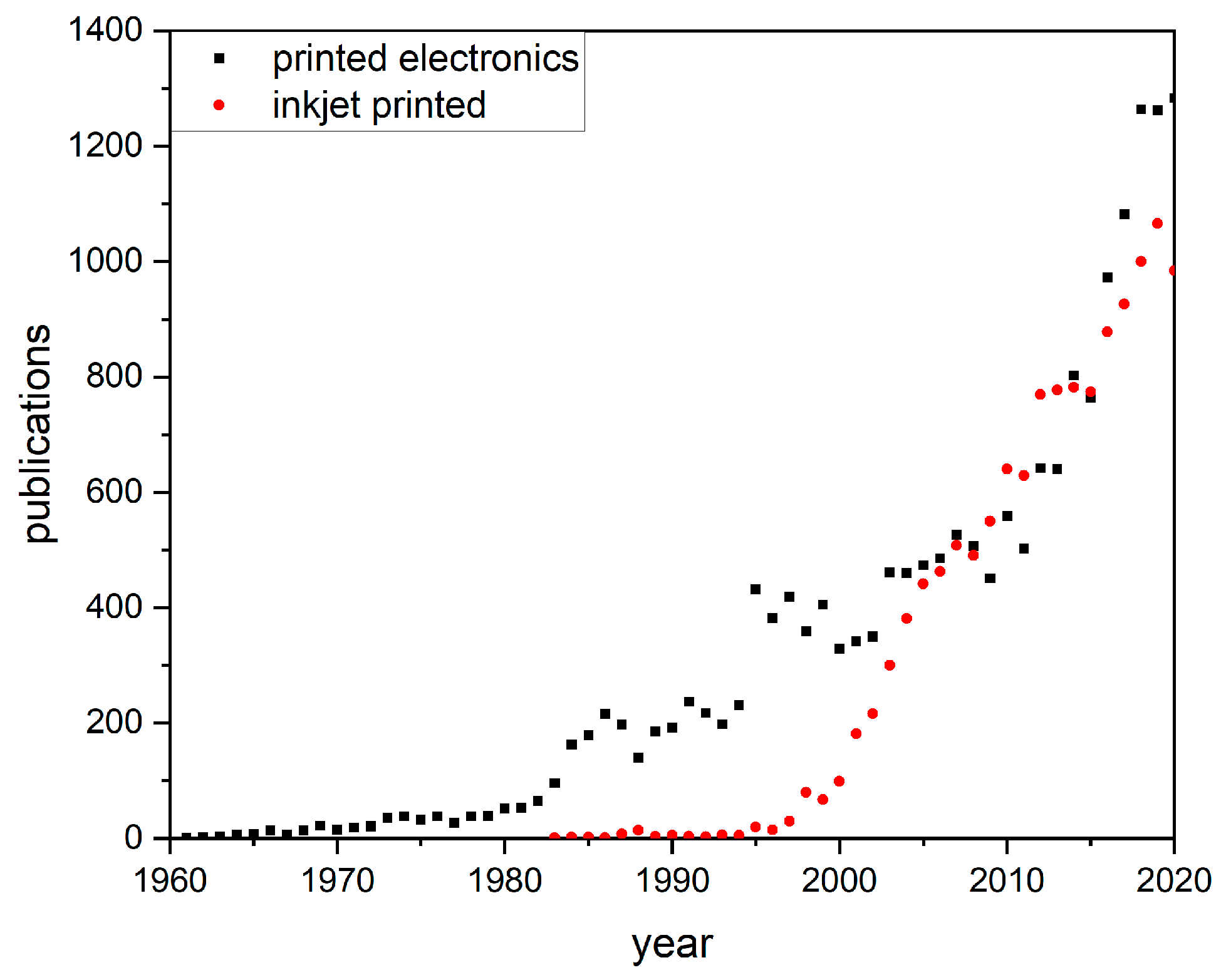
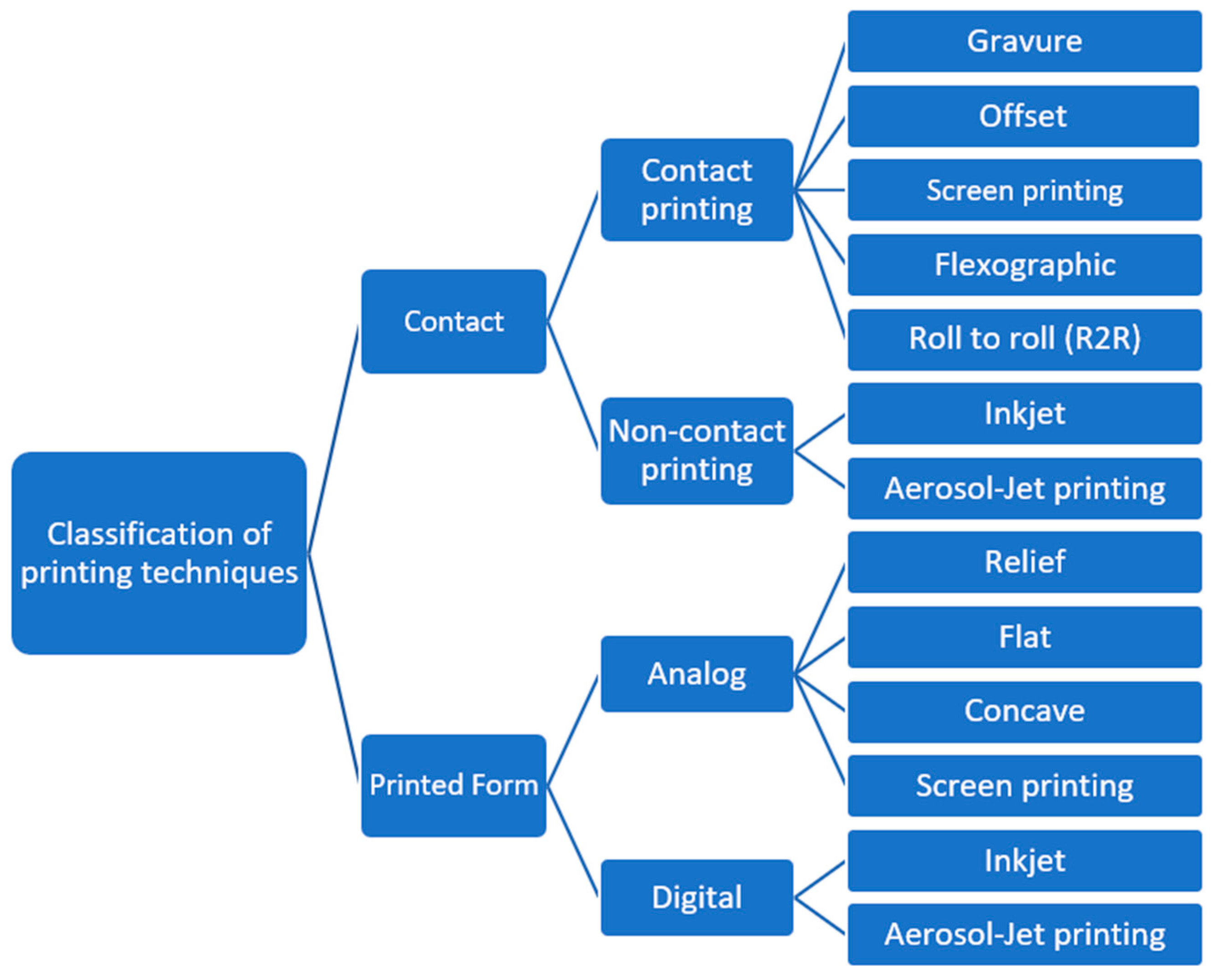

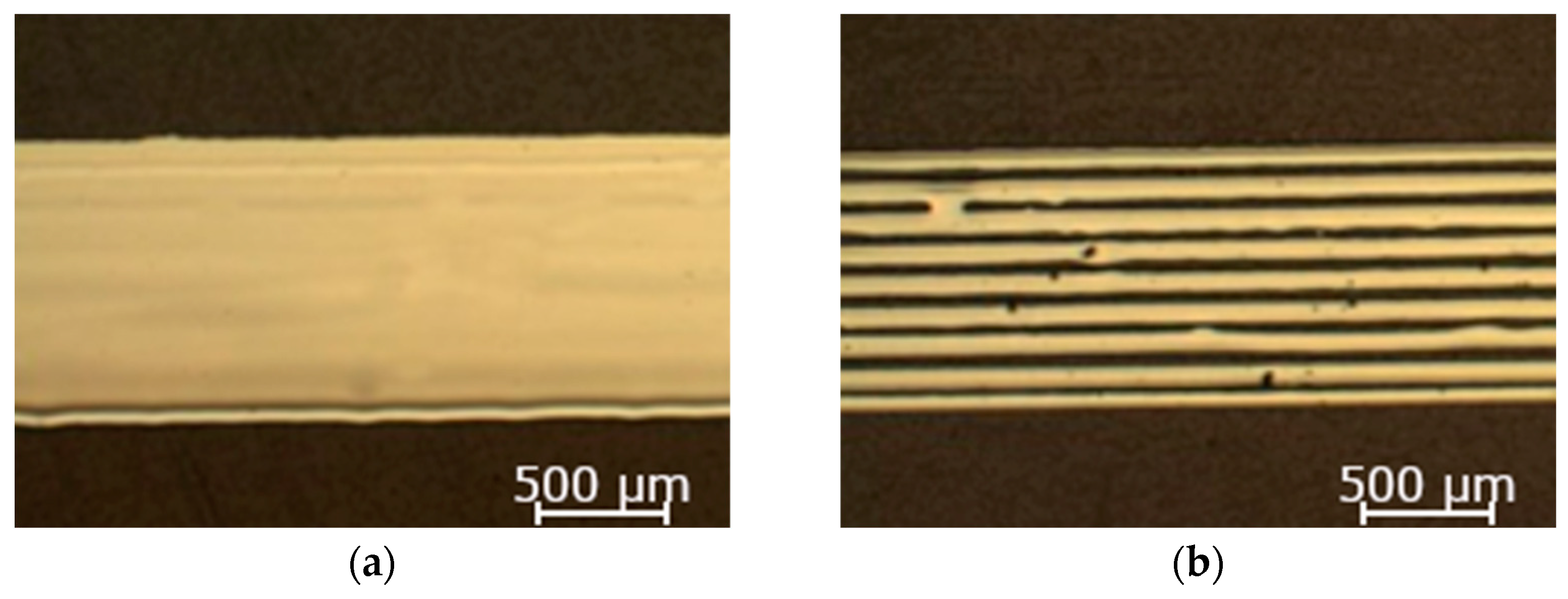
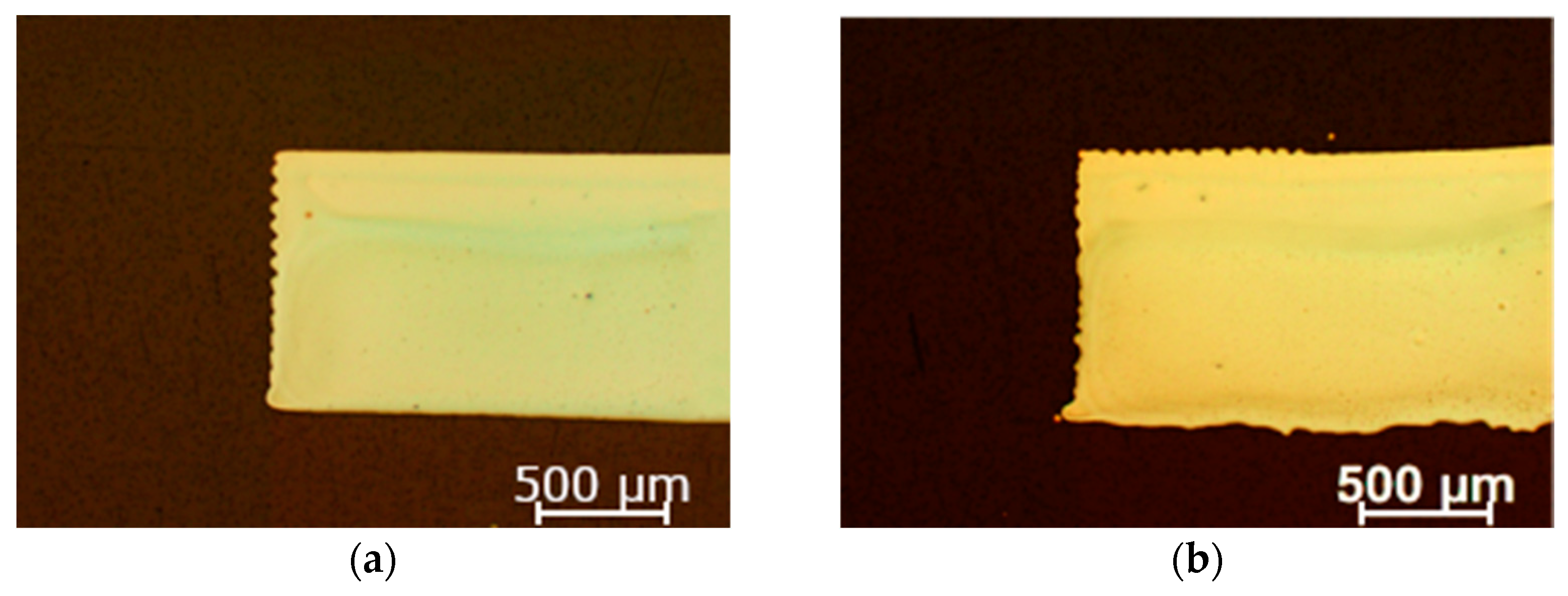
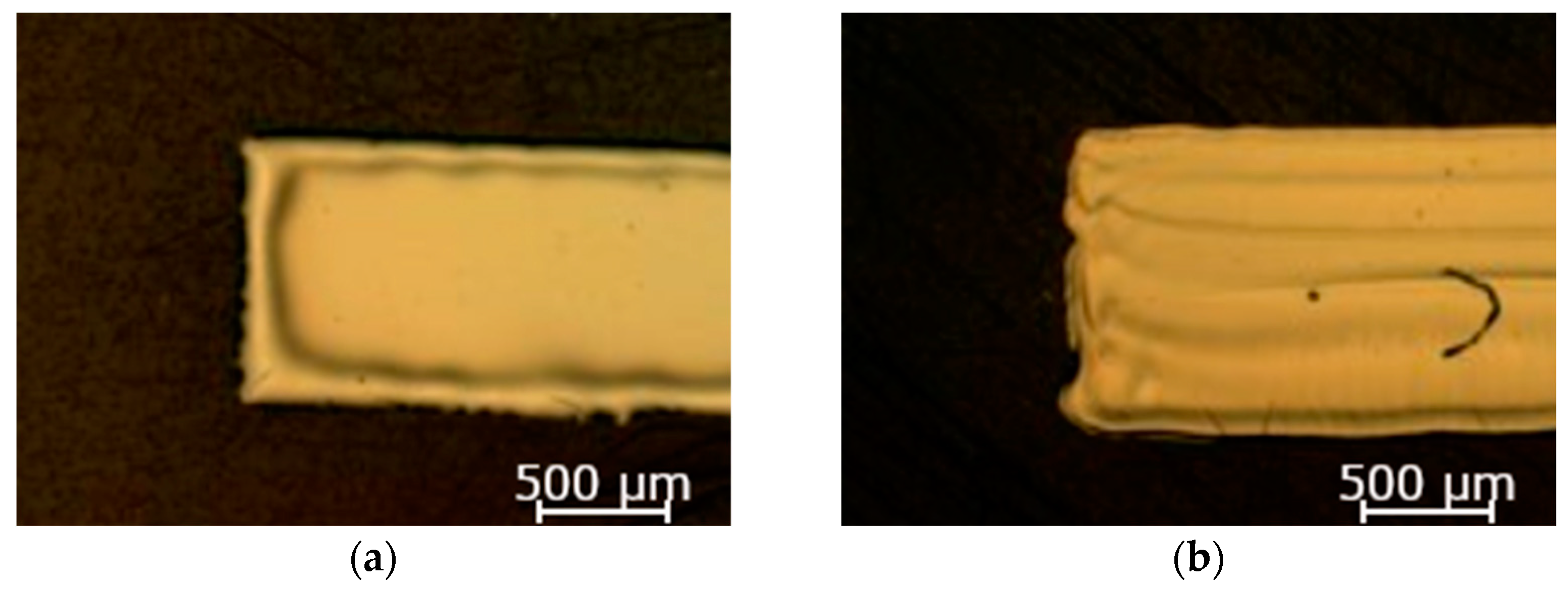
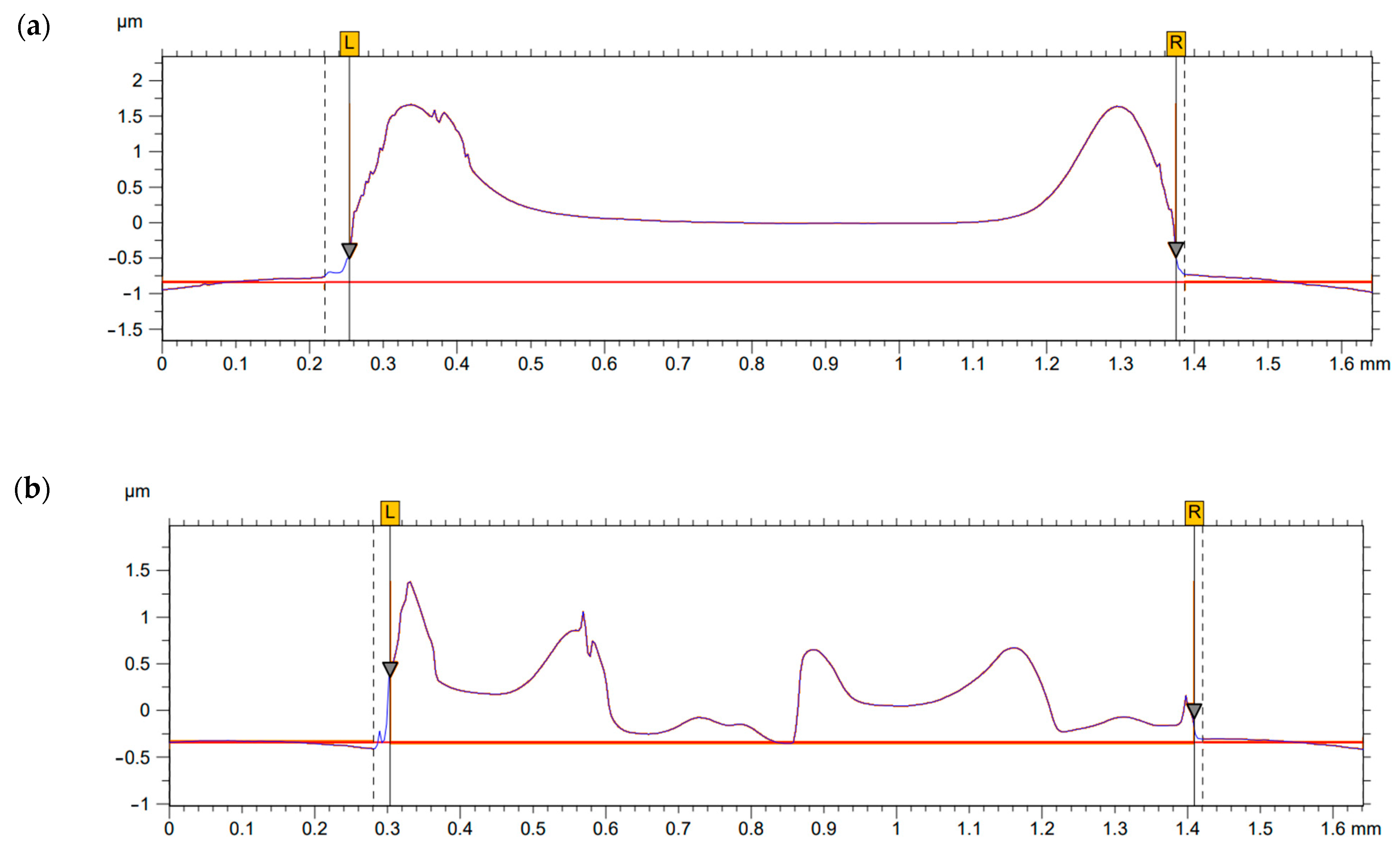
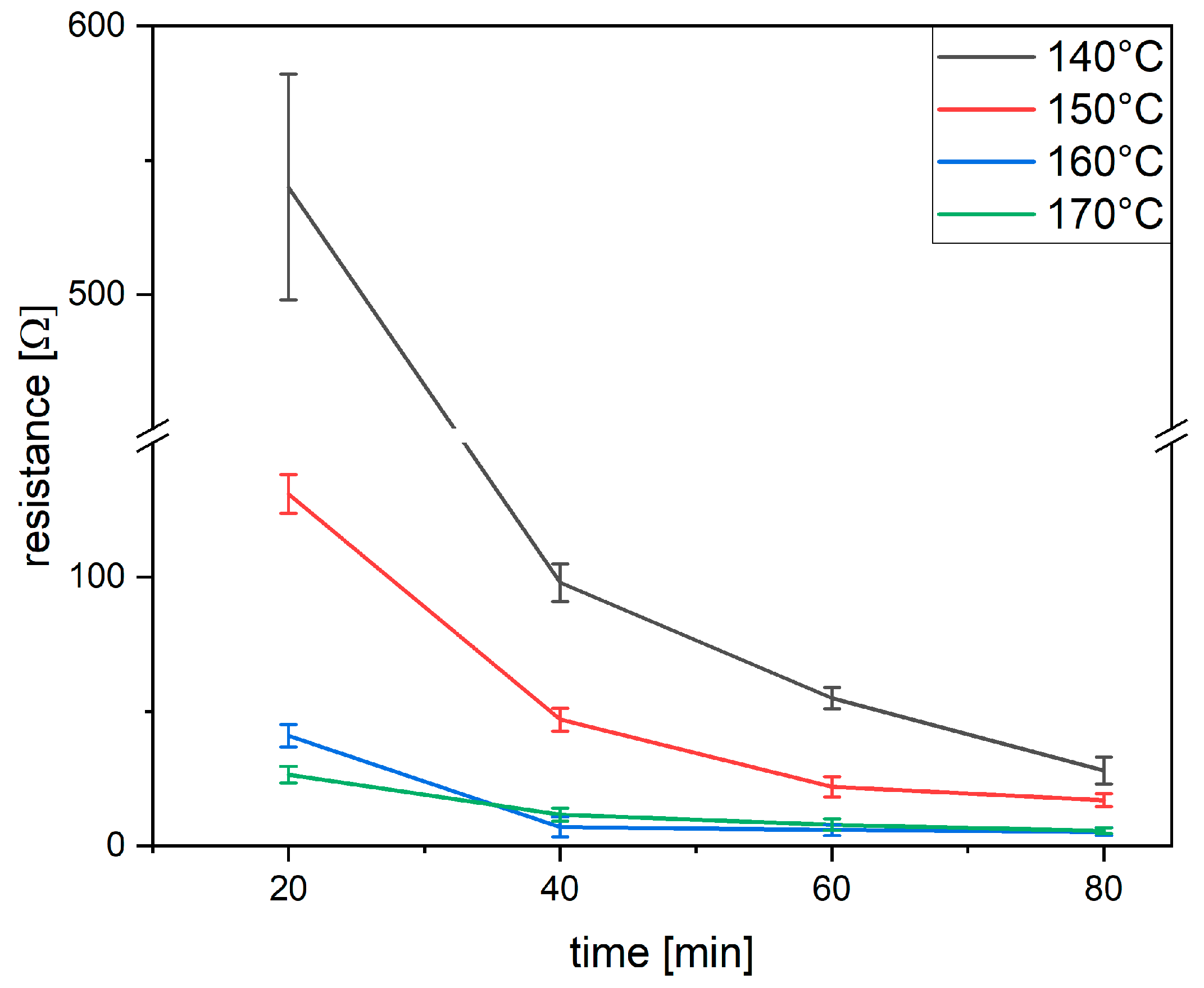


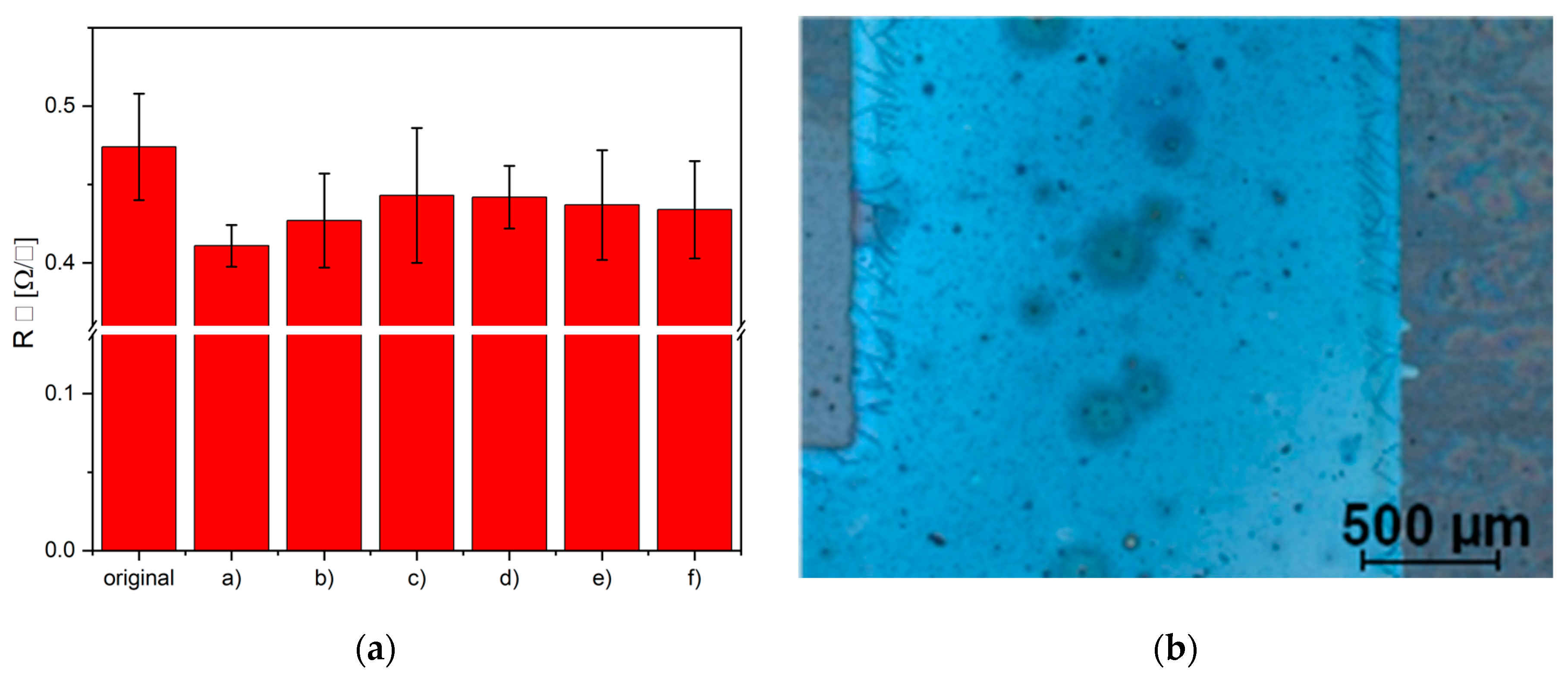

| Parameter | Drop Space | Cartridge Height | Table Temperature | Sintering Time | Sintering Temperature |
|---|---|---|---|---|---|
| [μm] | [μm] | [°C] | [min] | [°C] | |
| Value | 5 | 50 | 23 | 20 | 120 |
| 10 | 100 | 30 | 40 | 130 | |
| 15 | 150 | 35 | 60 | 140 | |
| 20 | 200 | 40 | 80 | 150 | |
| 25 | 250 | 45 | 160 | ||
| 30 | 300 | 50 | 170 | ||
| 350 | 55 | ||||
| 400 | 60 | ||||
| 450 | |||||
| 500 | |||||
| 550 | |||||
| 600 | |||||
| 700 | |||||
| 800 | |||||
| 900 | |||||
| 1000 | |||||
| 1100 | |||||
| 1200 | |||||
| 1300 | |||||
| 1400 | |||||
| 1500 | |||||
| ∑ | 60 | 210 | 80 | 40 | 60 |
| samples | samples | samples | samples | samples |
| Average Resistance | ||||||
|---|---|---|---|---|---|---|
| Time | Temperature | |||||
| 120 °C | 130 °C | 140 °C | 150 °C | 160 °C | 170 °C | |
| 20 min | 45.8 MΩ | 43 MΩ | 540.3 Ω | 131.4 Ω | 41.1 Ω | 26.5 Ω |
| 40 min | 1.3 MΩ | 29.7 kΩ | 98.4 Ω | 47.4 Ω | 7.7 Ω | 11.6 Ω |
| 60 min | 37.8 kΩ | 662.7 Ω | 55.9 Ω | 22.4 Ω | 5.9 Ω | 7.9 Ω |
| 80 min | 3.9 kΩ | 228.3 Ω | 29.9 Ω | 17.1 Ω | 5.3 Ω | 5.6 Ω |
| Designation of Test Conditions | Temperature | Humidity |
|---|---|---|
| (a) | Variable temperature cycle with extremes of −10 °C and 50 °C with a rise and fall gradient of ±2 °C/min | 40% |
| (b) | Variable temperature cycle with extremes of −10 °C and 50 °C with a rise and fall gradient of ±0.08 °C/min | 40% |
| (c) | 50 °C | 70% |
| (d) | 50 °C | 20% |
| (e) | 30 °C | 70% |
| (f) | 30 °C | 20% |
Disclaimer/Publisher’s Note: The statements, opinions and data contained in all publications are solely those of the individual author(s) and contributor(s) and not of MDPI and/or the editor(s). MDPI and/or the editor(s) disclaim responsibility for any injury to people or property resulting from any ideas, methods, instructions or products referred to in the content. |
© 2024 by the author. Licensee MDPI, Basel, Switzerland. This article is an open access article distributed under the terms and conditions of the Creative Commons Attribution (CC BY) license (https://creativecommons.org/licenses/by/4.0/).
Share and Cite
Kiliszkiewicz, M. The Impact of Technological Parameters on the Quality of Inkjet-Printed Structures. Electronics 2024, 13, 423. https://doi.org/10.3390/electronics13020423
Kiliszkiewicz M. The Impact of Technological Parameters on the Quality of Inkjet-Printed Structures. Electronics. 2024; 13(2):423. https://doi.org/10.3390/electronics13020423
Chicago/Turabian StyleKiliszkiewicz, Milena. 2024. "The Impact of Technological Parameters on the Quality of Inkjet-Printed Structures" Electronics 13, no. 2: 423. https://doi.org/10.3390/electronics13020423






